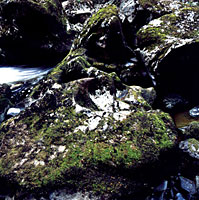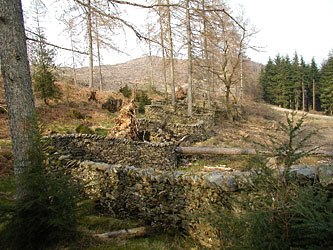Beauty and the Brand:
Andy Goldsworthy as challenge to radical relativism

Midsummer Snowballs – Beech branches/Finsbury Square & Moorgate
/
Early Afternoon/21 June 2000, 2000. View of one of the Midsummer Snowballs
installed around the Barbican Arts Centre area of the City of London.
Early Afternoon/21 June 2000, 2000. View of one of the Midsummer Snowballs
installed around the Barbican Arts Centre area of the City of London.
In the comments book to Andy Goldsworthy's Time exhibition at the Barbican in the high summer of 2000, one visitor had written Goldsworthy's work 'has a beautiful meditation to it'. Repeatedly it is this word 'beautiful,' which is associated in the public mind with what Goldsworthy makes. In other quarters, including some of the arts' world fraternity, the aesthetic category of 'beauty' has long been suspect, and partially in consequence, one suspects, because his audience relates to the work as 'beautiful', Goldsworthy has come unstuck with some in the theory and book-led knockabout of art criticism. Unsurprisingly, he neither repudiates beauty, nor sees it as irrelevant to the present day.
"Nature is intensely beautiful," he says, "and at the same time very unnerving, and at times deeply frightening. You feel it if you've ever stood in a wood that has been blown down after a strong wind, a volcano, or any of these incredible acts of nature. You feel it as soon as you go out to the land, where everywhere you go things are dead, decaying, fallen down, growing, alive. There's this incredible vigour and energy and life. And it's sometimes very difficult to deal with. I would hope that I don't have a kind of romantic view of nature. I do feel the beauty of it, for sure. But it's a beauty that's underwritten by extreme feelings."


Outdoor works – Andy Goldsworthy 2005

Goldsworthy – Marks on a tree - 2005
Some autumns ago I happened to visit the oldest of the sculpture parks, Grizedale, in the Lake District. For many years it was at the leading edge of what may be called, for want of a phrase, the mid-period emergence of British Land Art. David Nash's work was present as was early commissioned work by Andy Goldsworthy. But during the nineties this by now established Land Art pathway was felt to be outdated. Audiences were dwindling. The proprietors, the Forestry Commission, felt radical action was needed. Grizedale required a relaunch, and as part of its relaunch it would need to be rebranded with the busy work of a completely new image templated over the decaying leaf fall of the old.

Taking a wall for A Walk – Grizedale Sculpture Park –
Goldsworthy's well known early dry stone wall project
in Grizedale forest.
Goldsworthy's well known early dry stone wall project
in Grizedale forest.
The revolution has been continuing at Grisdale. And what has been happening appears in many respects to represent the extension of the aesthetics of eighties art as shock by another name into the deep rural. At the heart of its aesthetic is a perspective which doesn't give credence, and isn't interested in the experience of a 'living' natural world. By contrast the land artists were a reflection of a culture re-discovering the living qualities of the more than human world, and the immediacy of being in the world. Land Art was interested in beauty, and in another notion often ignored in the art lexicon, delicacy, which in the metropolitan urban melting pots feel irrelevant. That said, the trauma unfolded by the destruction of the Two Towers on September 11th 2001, may have brought people to re-evaluating the place of beauty and indeed, delicacy, in balance with the avant-nihilism which is so much part and parcel of current art actions out on the streets.

And more recently….
"Life and being alive is a form of beauty," Goldsworthy says. "This is our, and my, time. And yes...there is a beauty." Goldsworthy ponders for a while. "I think beauty contains a sense of truth, and that is really the difficulty, there is something in the sensibility of beauty that actually isn't a real beauty at all but is just prettiness and decoration. These are very, very difficult areas. I fly very close to the wind at times, and there are occasions when I fail, and the piece veers towards decorativeness. I fight that all the time, but I take on difficult subject matters. Flowers, petals, and leaves. Snow and ice. These are subjects that have been layered with sentimentality for so long that we can't see these things any more. It is a very brave thing to do to take them on and to work with, a sunset (for instance)! Everyday the sun rises and sets and at times it is this fantastically spectacular, deeply disturbing event, that happens. This blood red sun

Clay Wall, 2000. - Site-specific installation of wood,
hair,
and clay extracted from the grounds of Storm King
Art Center. Executed with the help of wallers from Scotland.
Photo: Galerie Lelong
and clay extracted from the grounds of Storm King
Art Center. Executed with the help of wallers from Scotland.
Photo: Galerie Lelong
"Sometimes I think that we're so frightened of nature and so frightened of death, that we like to play with it and look at it. It's a way of us trying to avoid it if we can look up its arsehole. And if we've done that, we're okay, we can handle that. But in fact it's still there. Nature is that, it's death. Our nature is that we will die. And if I feel that every time I go to work, then the work comes to life, I bring it to life, and then it dies. Every day there is this great sense of loss."
"Loss is something that we have problems dealing with. I mean I lose things, I lose my work everyday. We lose our youth as we grow, we're all losing our parents, losing people we know, we're losing all the time. There's a deep sense of loss… (very quietly) It's what I'm dealing with in my work. And I'm not doing it out of a sense of anti-art bravado. It hurts me to see these things die, fall down, collapse, decay. But then I see the beauty in that, the sense in that. A lot of the recent work is actually about the decay, the changes actually making the work stronger and so it develops into something else."

Midsummer Snowballs – Beech branches/Finsbury Square &
Moorgate/Early Afternoon/21 June 2000, 2000.
Moorgate/Early Afternoon/21 June 2000, 2000.

More of the Midsummer Snowballs
installed around the Barbican Arts
Centre area of the City of London
installed around the Barbican Arts
Centre area of the City of London
Goldsworthy is not sure whether the urban environment allows only a limited exposure to that experience of a hands-on connection with the materials which have a wider context with the whole or not. "I think there are possibilities everywhere to find some sense and I think the best works I've made on, for instance, pavements are the ones where I've lain in the rain and left a shadow. The feeling of the human imprint on the pavement, the walking of people's lives passing through and the wearing down of the paving. The human presence is ingrained into the pavement when I lie on it and leave a shadow. And then the shadow dries up or gets rained over, and I think that articulates a way of understanding something of the nature of the urban place. But the idea of going to a garbage dump and starting to re-arranging garbage would be hard to do, I think. And maybe it's something I haven't come round to understanding yet. Maybe I could."
OL
This is a version of part two of the Andy Goldsworthy feature which appeared in Fourth Door Review 7, alongside an interview with Thomas Riedelheimer, director of Rivers and Tides, the award winning documentary on Goldsworthy and his work, see here. Part one appeared in Fourth Door Review 6 and focuses on, amongst other material, on the relationship between Goldsworthy's work, new media and performance art.